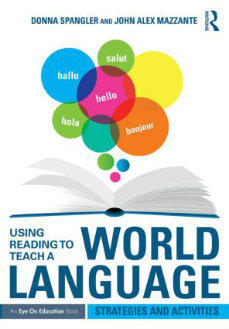Use Reading to Teach a World Language
Using Reading to Teach a World Language
By Donna Spangler and John Alex Mazzante
(Routledge/Eye On Education, 2015 – Learn more)

My colleagues and I gave the Assessment of Performance toward Proficiency in Languages (American Council on the Teaching of Foreign Languages) to our students in the fall of 2015 and then again in May of 2017.
Although delighted with our students’ overall growth in two years, we noticed that the area of reading showed the least amount of growth. I was surprised as I thought I had included many interpretive tasks in my curriculum throughout the year.

Inside the book
I would divide this book into three sections:
1 – Theory. There is an initial, brief, theoretical component in which the authors underline the importance of intentionally incorporating reading strategies in the curriculum at all proficiency levels.
As my incoming world language students are typically at the novice-low to novice-mid level, I focus on the listening and speaking skills, trying to provide them with a rich, spoken language environment. Ideally, I want to advance my students to intermediate-low – “flesh and blood speakers,” through daily, repeated conversations, mastering about 350 basic words.
However, relying on daily events as a source of conversation is limiting because it is repetitive. How often have we talked about weather, sports, and Justin Bieber! To expand on this functional speaking, other “events” need to occur. Reading is a way to provide an “event” – another topic of conversation in a contextualized setting!
2 – Strategies. The second section provides 36 reading strategies and 26 reading activities. The authors use bullet points to introduce each activity; state whether it is useful as a pre-reading, during, or post-reading task; indicate the goal of the strategy; and show how to use and adapt it. They also use illustrations to clarify descriptions. It is easy and quick to find exactly what you are looking for.
Some of the strategies are not new – story mapping, SQ3R, graphic organizers. However, most of the activities have a “twist” that makes them more playful or less arduous. One of my favorite suggestions is “Would You Bet On It?” In this activity, the students receive a small piece of paper. On one side is a copy of the currency of the target culture; the other side is blank. As students are listening to/reading a story, the teacher stops at certain moments and asks the students to infer what is going to happen.
The students write their predictions on the blank side. If they are correct, they keep their “money.” You can imagine the different ways that this activity can be adapted and used throughout a semester as they accumulate slips. What a great way to have the students focus on the first reading!
Another interesting activity is “Radio News Broadcast.” After reading a text, students in groups select important parts of the text, dramatizing a part and/or interviewing a character. In this way, they focus on the main idea and the events that advance the action. Stronger students support weaker learners as they prepare their presentations.
What I especially value in this section are the activities that go beyond simple recall. All students from novice to more advanced levels infer, apply, and reflect on the text.
3 – Resources. The final section includes online resources, references, and downloads. I found some of the resources valuable; a few require registration; several had more of a grammar focus. The collection of downloads includes templates for many of the strategies/activities summarized in the second section – very useful.
In conclusion, I highly recommend this book. It is organized, brief, with multiple activities and strategies easily adapted to all learners that add variety and playfulness to the lesson. It is definitely a “go to” resource to keep on your desk as you plan.
Jane Swisher is a National Board Certified Spanish teacher and world language coordinator at Deer Path Middle School, District 67 in Lake Forest, IL. She has taught for 38 years in both the United States and overseas. As a member of ICTFL, Illinois Council on the Teaching of Foreign Languages, she was one of the original TALL-IL Teacher-Leaders and is an Oral Proficiency Interview (OPI) training alumni. Jane has also attended the ACTFL sponsored LILL leadership conference in the summers of 2015 and 2016.






























